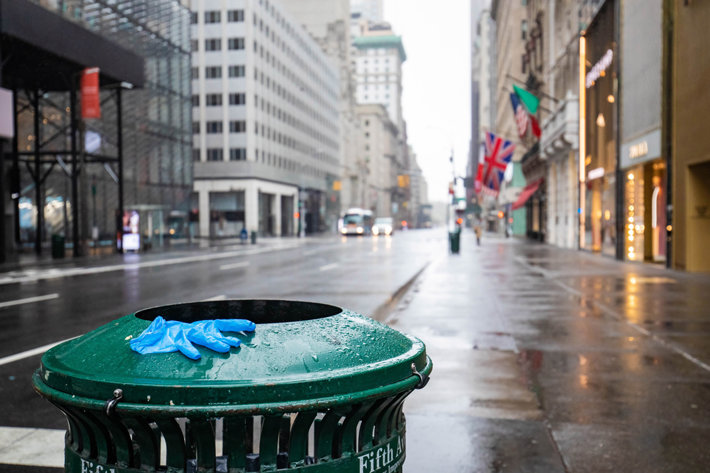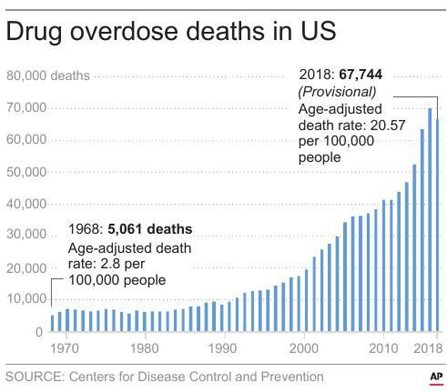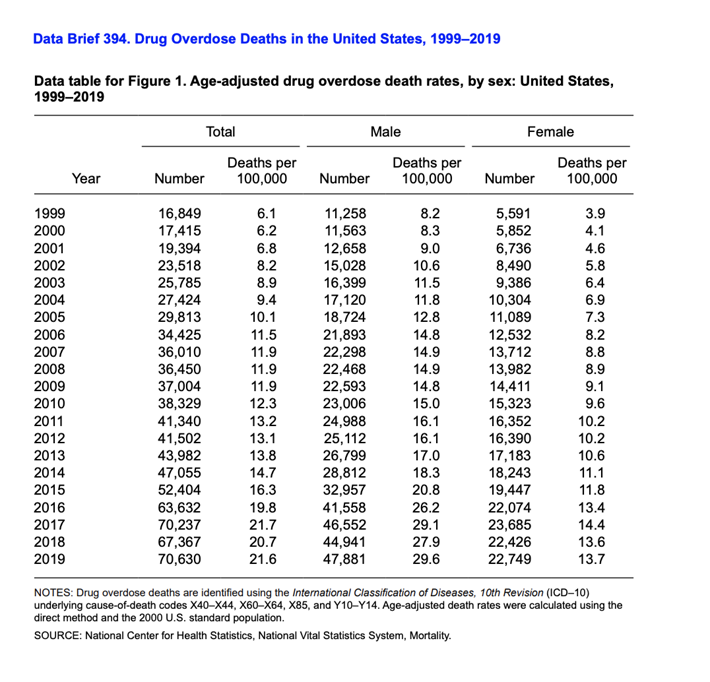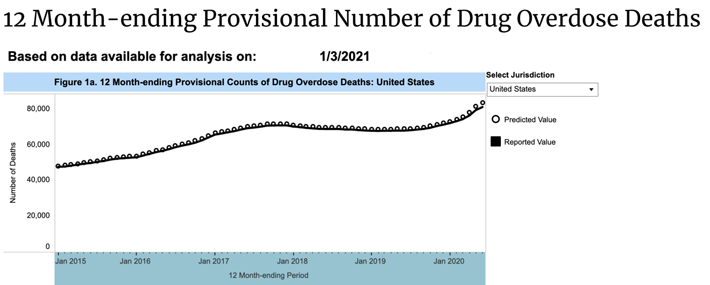Are We Doing Enough to Eliminate Drug Overdose Deaths?

A couple of years ago, newspapers and magazines were splashed with frequent headlines about the opioid overdose problem in America. There were reports of rallies in Washington, D.C. and state capitals to inspire legislators to take a larger role in fighting this problem. Grassroots groups around the country engaged their communities so they would take greater action to save lives.
And now? It’s like the problem has disappeared from the headlines, from the streets of our capitals and small towns.
But the problem has not gone away. Not even close.
Some people are definitely paying attention. Unfortunately, the ones paying the closest attention are those who are losing their loved ones. And that’s just wrong. Because at this writing, we are losing our friends, neighbors and family members in record numbers.
The national problem of drug overdoses deserves to be splashed across the headlines every day until there’s an effective solution.
Could it be that people simply don’t realize the magnitude of the problem? Or the losses we are suffering?
One Way to Grasp This Magnitude
According to the CDC, since 1999, we have lost 840,000 Americans to overdoses. That’s a huge number. What happens if we translate that number into something that is never overlooked by the media: airline crashes. When a big plane crashes, it’s not only front page news, it also triggers immediate action by multiple government agencies to determine the cause and eliminate the possibility of further crashes.
So what if we had lost this many people in airline crashes? What would that look like? Let’s look at the Boeing 737 to get an idea.
The Boeing 737 aircraft can carry roughly 220 individuals.
Losing 840,000 Americans would mean 3,800 crashes of the Boeing 737 airplane since 1999. That’s 181 crashes a year or 3.5 crashes each week.
For contrast, one of the 737 models, the 737 MAX, crashed two times, once in 2018 and once in 2019. After the second crash, it was grounded worldwide.
In overdose losses, we have had the equivalent of 3-and-a-half Boeing 737 crashes each week, week after week for 21 years, and there’s silence from major media, our leaders in government and the agencies they run or are responsible for.
Another Way to Look at It
What if we lost a major American city over a period of 21 years? Not because people moved away but because they began to die and year after year, continued dying until the entire population was extinguished.
I’m talking about a city like Seattle, Indianapolis or San Francisco—gone over a period of 21 years. Just gradually wiped out with every resident dead and buried. How many months or years could this possibly go on before the public would demand immediate action from every relevant government agency?
If multiple airplanes crash or if a hypothetical city were wiped out, the drama and shock of this loss would galvanize the public, media and government to take action. Our drug overdoses losses are slow and agonizing. Without this shock and drama, perhaps we are not as motivated to take action. But we should be. We are losing hundreds of thousands of bright, productive individuals who took a wrong turn and ended up addicted.
Invisible Victims
Those who tumble into addiction are nearly-invisible victims, too often grieved for only by their loved ones. The media and agencies responsible for the health of Americans are entirely missing this story. Perhaps they have just gone numb because of the never-ending numbers. Or perhaps other social issues have simply overwhelmed the story.
While 2020’s headlines were focused far from the problem of drug addiction, America reached unenviable new levels of loss from drug overdoses. I remember celebrating in 2018 when overdose deaths began to drop slightly after decades of steady increases. We lost any ground that had been gained by the time 2020 arrived.

Look at this chart of drug overdose deaths from 1968 through 2018. You can see a gentle dip in 2018. For the first time since 1990, we lost fewer people to this cause.
From today’s viewpoint, it hardly seems possible that at one time we only had 5,000 drug overdose deaths in the entire country. That rate of deaths—2.8 per 100,000 population—increased more than seven-fold by 2018 and even more since then. What an infinitesimally small number it seems compared to our losses today.
Each death means that this catastrophic loss broke the hearts of anywhere from one to dozens of people who loved the person who lost their life.
What Happened After 2018?
In 2019, the rate of drug overdose deaths per 100,000 people increased from the 20.57 you see in the graph above to 21.6 per 100,000.
Here's the table showing this increase.

And what does 2020 look like? While all the numbers are not yet in for 2020, the Centers for Disease Control and Prevention (CDC) offers a monthly update that shows the terror-inducing future we are headed for. In this monthly update, each month’s figure shows the total of the last twelve months of overdose deaths. So the number for February 2020 is the total of all deaths from March 1, 2019 through February 29, 2020.

You can see the black dot indicating how many overdose deaths have actually been reported in that twelve-month period and the little circle indicating the estimated number of deaths that will be reached once all the death reports have been turned in to the CDC.
It was in November 2017 that we first hit a peak and the numbers began to decline. From 70,723 reported deaths in November, the number dropped just 24 in December. The decline lasted until February 2019 when the number of reported deaths was 67,631.
By December 2019, the number or reported deaths had climbed back to 71,130 with the total estimated at 72,151. We were setting a new record for overdose losses as of this month.
In 2020, the numbers began to climb more sharply.
The first number is the reported number and the second is the estimated total when all reports are finalized.
- January: 72,006 — 72,731
- February: 73,076 — 74,163
- March: 74,226 — 75,687
- April: 76,258 — 77,851
- May: 79,296 — 81,318
- June: 81,003 — 83,335
This is a disaster that is being completely overlooked by the media, agencies, non-profits and communities.
How Can We Possibly Have a Win in This Fight?
Actually, there’s no shortage of good ideas on how to fight this problem.
A national push to fight drug abuse can and should start at the top of our country—government figures, corporate leaders, prominent and influential figures of all types. They can inspire and lead others.

What kind of actions could these people spearhead and inspire?
- Eliminate agency redundancies in the fight against drugs to make available monies go further.
- Utilize research showing the best success in providing rehabilitation that results in people staying drug-free after completion, not replacing one drug for another.
- Make these successful programs widely available to those who are addicted.
- Motivate community groups to refer those who are addicted to these programs.
- Recruit well-known spokespeople from all walks of life to increase the popularity of drug-free lives.
- Recruit churches and youth organizations to participate.
- Find ways to incentivize anti-drug activities by community groups, non-governmental organizations and corporations
- Distribute a single anti-drug message instead of a confusing flurry of messages.
- Intensively educate the public with specific and honest information on the harm done by drug use.
- Target youth in particular with drug prevention education but only use those curriculums that have track records of preventing the start of drug use.
- Evaluate the effect of harm reduction messages to see how often they lead to sobriety, or if they increase drug use, especially among youth.
- Work out ways to validate and reward youth for remaining drug-free.
There must be more rehabilitation and it must be more successful. There must be more drug prevention lessons for the young and anti-drug messages for all ages. There are many more actions that must take place but these steps are a start in the right direction.
Sobriety must be made popular and a mark of success. Rehabilitation must work and existing or new research must focus funding on programs that result in rehabilitated lives, not just maintenance on substitute drugs.
When we pull together as a nation and in each of our communities to make actions like these a reality, we can once again see these losses decline.
Sources:
- https://www.cdc.gov/drugoverdose/pdf/pubs/2019-cdc-drug-surveillance-report.pdf
- https://www.seattletimes.com/business/boeing-aerospace/after-analyzing-satellite-data-on-737-max-crash-canada-bans-the-plane-from-its-airspace/
- https://www.postregister.com/drug-overdose-deaths-in-us/pdf_0be43d42-f50a-5d3b-9171-c085dd543ca3.html
- https://www.cdc.gov/nchs/nvss/vsrr/drug-overdose-data.htm\
- https://www.cdc.gov/nchs/data/databriefs/db394-tables-508.pdf#page=1


 ®
®